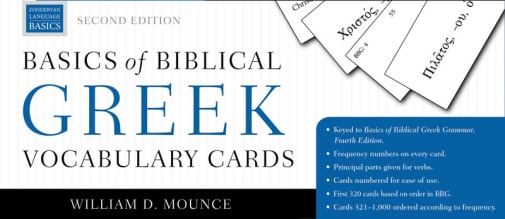When a program is recommended by a major classical publisher (Veritas), we're going to take notice. Such is the case with Basics of Biblical Greek. Originally intended for (and used for over two decades in) Bible schools or seminary classrooms, it's a comprehensive and thorough introductory study of Koine Greek with the goal of giving the student tools by which he (or she) can better understand the Word of God and correspondingly share that understanding with those around him/her.
Utilizing and intertwining the methodologies of two philosophies of language acquisition, the course allows the student to get into textual material as soon as possible, employing the natural learning process (inductive learning) for fine tuning while at the same time using charts and rote memorization as "first teaching" (deductive learning). In other words, the goal is to reduce the essentials to a minimum so the language can be learned and retained easily.
To do this the writing/lesson style is friendly - almost chatty - and "beyond basic" information is presented either with the help of a little cartoon professor who shows up in the margins or in the "Advanced Information" section at the end of each chapter. The result is a course that is inviting and promises to encourage the student along the way - and which seems very doable for the homeschooled high school student.
What do I mean by "encourage"? Well, first of all, most translation exercises are taken directly from the Bible. Vocabulary studies start with the nouns and a few other words (i.e. and) which are the most frequently used words in the New Testament. In fact, each vocabulary word has a frequency number and at the end of each lesson, the student is told what percentage of the entire NT vocabulary they now know. [Just to show how powerful this is, by the end of Lesson 9 (1/4 of the way through the course), that percentage figure is over 50%.]
The student has the option of following one of two tracks after Lesson 9. Track 1 continues with nouns while Track 2 alternates between noun chapters and later verb chapters. Each chapter ends with an exegesis section - knowing the grammar often makes a difference in the interpretation of the text. Since the Advanced Information is at the end of the chapter, it doesn't confuse, but at the same time does provide challenge material for students who are "into" the study. Memorization is kept to a minimum and a lexicon is provided for words used more than 10 times in the NT.
The Grammar - the basic course text - covers alphabet/pronunciation, nouns (nominative, accusative, genitive, dative, vocative), definite articles, prepositions, pronouns (personal, demonstrative, relative), adjectives, verbs (present active indicative, contract, present middle/passive indicative, future active/middle indicative, verbal roots, imperfect indicative, second aorist active/middle indicative, first aorist active/middle indicative, aorist and future passive indicative, perfect indicative), participles (present adverbial, aorist adverbial, adjectival, perfect, and genitive), and moods (subjunctive, infinitive, imperative, indicative, and non-indicative) in 36 chapters. Each chapter starts with an overview, then the lesson points (instruction), summary, and vocabulary lesson, ending with the previously mentioned advanced information and exegesis. There is an extensive reference appendix which includes grammar charts and paradigms as well as the lexicon and index. The "Professor" (in the margin) keeps things interesting by providing overviews and summaries, trivial/historical tidbits, and conversational Greek.
The Workbook (which is three-hole punched and perforated) includes exercises for writing out paradigms, parsing, warm-ups, translation, sometimes additional translation, and a closing summary. The answer key for the workbook is available as a free online download (see below).
The Vocabulary Audio CD and Vocabulary Card are somewhat self-explanatory. The CD provides pronunciation guidance - each chapter on its own track - as well as vocabulary practice (time provided to give the meaning). There are both MP3 and M4B files on the CD. There are 1000 1 ¾" x 3 ¼" - i.e. business card size - cards in the set. The first 320 cards are based on the BBG course presentation order while cards 321 - 1000 are ordered according to frequency. Each card provides the Greek on one side and the translation along with the BBG lesson number, the frequency in the NT number, and the card number on the reverse side.
The Graded Reader is "what comes next" after the basic course. Designed to provide biblical reading assignments for second and third year students, it progresses in difficulty but slowly incorporates intermediate grammar. Introducing an exegetical methodology called "phrasing," the student is also given tools for beginning exegesis. Each page includes the Greek text, footnotes which define words that occur less that 20 times in the NT, and exegetical discussions. An intermediate and advanced grammar - such as Greek Grammar Beyond the Basics by Daniel Wallace - is recommended.
There is amazing online support for this course offered by the author and others. billmounce.com/resources provides answers to all the exercises, keys to all the quizzes, and a free online class (billmounce.com/firstyeargreek.old. ~ Janice

